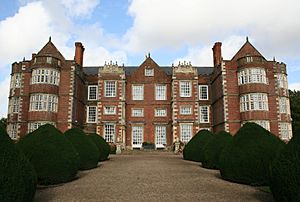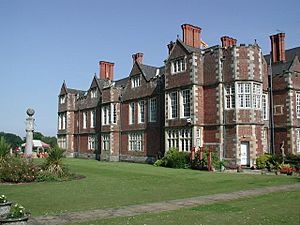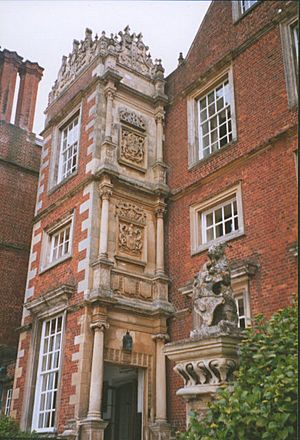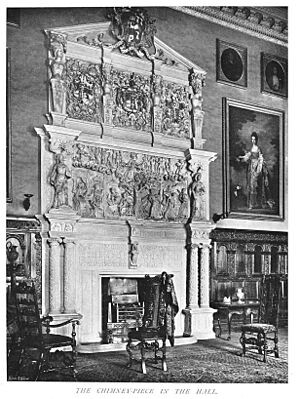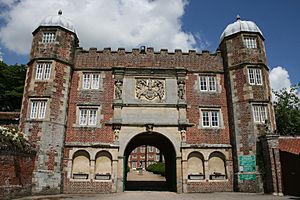Burton Agnes Hall facts for kids
Burton Agnes Hall is a grand old house in the village of Burton Agnes, near Driffield in Yorkshire, England. It was built by Sir Henry Griffith between 1601 and 1610. Many people believe the famous architect Robert Smythson designed it. Right next to it, you can still see the older Norman Burton Agnes Manor House, which was built way back in 1173. Both of these buildings are now considered very important historical sites.
Contents
Exploring Burton Agnes Hall
The design of Burton Agnes Hall is like a big square block with many bay windows. It even has a small courtyard inside. The front of the house, where you enter, is very grand. It has lots of windows and interesting shaped sections that stick out. There are square parts, round parts, and even five-sided parts around the corners! The roofline is also interesting, with pointed gables mixed with flat sections.
The main front of the house is built one storey taller than the rest. This is because it holds a very long room called the Long Gallery. This gallery runs all the way across the second floor. The entrance to the house is cleverly hidden on the side of a projecting section. This makes the front of the house look perfectly balanced.
Inside the Hall
The rooms inside the house are different sizes because of the bay windows. But the most amazing part is the Long Gallery. This room stretches along the entire front of the house. It has a beautiful, curved ceiling covered in rich plasterwork. Another important room, the "great chamber," was once a single large space. It is located on the first floor, above the parlour.
Even though the house has been updated many times, lots of original features from the 1600s are still there. You can see amazing carved wood, decorative plaster, and even alabaster. This includes several old plaster ceilings. There's also a special carved piece above a fireplace, called an alabaster overmantel. It shows a scene from the parable of the Ten Virgins. This carving was inspired by a famous painting by Pieter Bruegel the Elder.
Architectural Details
Robert Smythson had a big influence on Burton Agnes Hall's design. However, if you compare Smythson's original drawings with the house as it was built, you'll notice some differences. For example, his plan showed all four corner bay windows as five-sided. But in the actual building, two of them are round. Also, the door to the porch was shown at the front in the plan, but it was built on the side.
It's hard to know exactly why these changes happened. Maybe Smythson himself changed his mind. Or perhaps the Griffith family or the builders made some alterations. The round windows were probably Smythson's idea, as he used them in other designs. It's possible he planned a house with a flat roofline all around. But the owners might have preferred the gables we see today.
Beautiful Gardens
The gardens at Burton Agnes Hall are truly special. They have over 3,000 different types of plants! They even hold the National Collection of Campanulas, which are bell-shaped flowers.
Games in the Garden
The walled flower garden is designed with a fun games theme. There's a giant chess board made of black and white paving stones in the middle. Other garden areas feature games like draughts, snakes and ladders, and hoop toss. Each of these game areas is surrounded by plants chosen for their beautiful flower colours. There's also a market garden section with seasonal vegetables planted in a very attractive way. You'll find many whimsical and fun statues placed all around the grounds. Different artists display their work in the gardens and galleries throughout the year. The woodland walk is also very popular locally. It's known for its amazing display of snowdrop flowers in February.
Both the Elizabethan Hall and the remains of the old Norman manor house are open for visitors to explore throughout the year.
History of Burton Agnes Hall
The land and houses at Burton Agnes have been owned by the same family for a very long time. The first manor house was built here in 1173 by Roger de Stuteville. Later, in 1457, Sir Walter Griffith came to live there. The Griffiths were a Welsh family who had moved to Staffordshire. They inherited the Burton Agnes estate.
Building the New Hall
The current Elizabethan house was built nearby between 1601 and 1610. Sir Henry Griffith, who was the first Baronet of his family, had it built after he became part of the Council of the North. His daughter, Frances Griffith, inherited the estate. She married Sir Matthew Boynton, who was the Governor of Scarborough Castle. When Frances passed away in 1634, the estate went to their son, Francis. He later became the second Baronet Boynton.
There's a famous legend about Sir Henry's youngest daughter, Anne. People say her skull is bricked up inside the Great Hall. The legend claims it's a "screaming skull." It's said that if the skull is ever removed from the house, it will always find its way back!
Later Generations
The wife of the 6th Baronet married a man named John Parkhurst. He was known as "Handsome Jack." Sadly, he spent a lot of the family's money and didn't take good care of the estate.
When the eleventh Baronet passed away in 1899, the house went to his daughter. She had married Thomas Lamplugh Wickham, and they added "Boynton" to their last name. After her passing, the property went to their son, Marcus Wickham Boynton. He ran a very successful horse breeding farm on the estate for many years. He passed away in 1989. He left the property to a distant cousin, Simon Cunliffe-Lister, who was only twelve years old at the time. Simon is the grandson of Viscount Whitelaw.
Today, the estate is owned by the Burton Agnes Preservation Trust. Simon Cunliffe-Lister and his mother, Dame Susan Cunliffe Lister, manage the property.
A special railway engine, a Hall Class train, was even named Burton Agnes Hall. You can still see it preserved at the Didcot Railway Centre.


